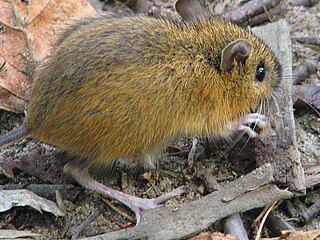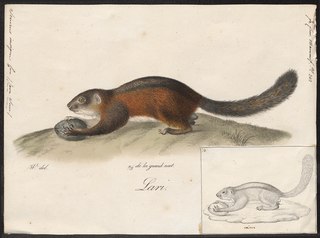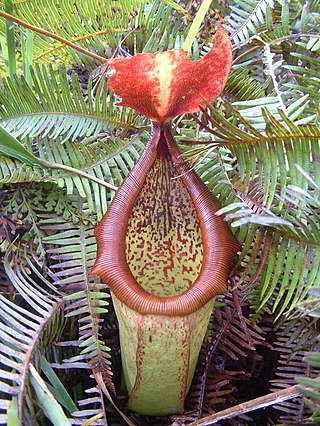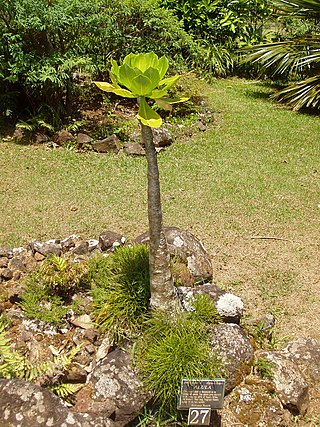
The woodland jumping mouse is a species of jumping mouse found in North America. It can jump up to 3 m (9.8 ft) using its extremely strong feet and long tail.

Striped ground squirrels form a taxon of squirrels under the subfamily Callosciurinae. They are only found in Southeast Asia. Species in this genus include:

Nepenthes insignis is a tropical pitcher plant endemic to New Guinea and surrounding islands. The specific epithet insignis is Latin for "distinguished" or "remarkable".

Brighamia insignis, commonly known as ʻŌlulu or Alula in Hawaiian, or colloquially as the vulcan palm or cabbage on a stick, is a species of Hawaiian lobelioid in the bellflower family, Campanulaceae. It is native to the islands of Kauaʻi and Niʻihau, but has been extinct in the wild since at least 2019-2020. This short-lived perennial species is a member of a unique endemic Hawaiian genus with only one other species.

The Mindanao montane forest mouse is a species of rodent in the family Muridae. It is found only in the Philippines.
Nouelia insignis is a species of flowering plant in the family Asteraceae, and the only species in the genus Nouelia. It is found only in Yunnan and Sichuan provinces, China, where it is threatened by habitat loss.

The feline owlet-nightjar is a species of bird in the family Aegothelidae. It is found in New Guinea. Its natural habitat is subtropical or tropical moist montane forests.

The pink-legged rail, also known as the New Britain rail, is a species of bird in the family Rallidae.

The brown-capped weaver is a species of bird in the family Ploceidae. It is found in Angola, Burundi, Cameroon, Republic of the Congo, Democratic Republic of the Congo, Equatorial Guinea, Kenya, Nigeria, Rwanda, South Sudan, Tanzania, and Uganda.

Cassin's honeybird, also known as Cassin's honeyguide, is a species of bird in the family Indicatoridae.

The three-striped ground squirrel is a species of rodent in the family Sciuridae. It is found in Indonesia, Malaysia, and Thailand.

The Cameroon scaly-tail, also referred to as the Cameroon anomalure, flightless anomalure or flightless scaly-tail, is a rodent species endemic to West Central Africa. The scientific literature has never reported observations of live individuals. The taxonomic classification of the species has been subject to recent revision.
Brycon insignis, the Tiete tetra, is a species of fish in the family Characidae. It is endemic to the Paraíba do Sul River basin in southeast Brazil. B. insignis migrates upstream to spawn and has traditionally been important to fisheries, but it is now a threatened species.

Afrothismia is a genus of myco-heterotrophic plants in the family Burmanniaceae, first described as a genus in 1906. It is native to tropical Africa.
Afrothismia winkleri is a species of plant in the Burmanniaceae family. It is found in Cameroon, Nigeria, and possibly Uganda. Its natural habitat is subtropical or tropical moist lowland forests. It is threatened by habitat loss.
Mesogyne insignis is a species of flowering plants in the family Moraceae. It is the sole species in genus Mesogyne. It is a tree native to the island of São Tomé in the Gulf of Guinea and to eastern Tanzania.

Sorbus insignis is a species of rowan. It is a tree to 10–15 metres (33–49 ft) tall, rarely a shrub. It is native to SW China, NE India, Myanmar, and Nepal.
Brenierea insignis is a species of flowering plants in the legume family, Fabaceae. It belongs to the subfamily Cercidoideae and is the only member of the genus Brenierea. It is endemic to Madagascar.

Afrothismia baerae is a member of the genus Afrothismia. It is endemic to Kenya and is critically endangered due to loss of habitat.
The East Asian free-tailed bat was formerly considered to belong to the same species as the European free-tailed bat. Its range includes China, Japan, and the Korean Peninsula.












